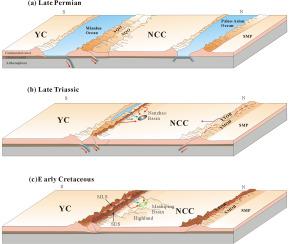Geoscience Frontiers ( IF 8.9 ) Pub Date : 2020-12-16 , DOI: 10.1016/j.gsf.2020.11.004 Anqi Wang , Debin Yang , Haotian Yang , Maosong Mu , Yikang Quan , Leran Hao , Wenliang Xu

|
Mesozoic sedimentary units within the Nanzhao and Mashiping basins record the paleogeographic and tectonic evolution of the Qinling Orogen (QO). This study uses new detrital zircon U Pb ages and Hf isotopic data to constrain the timing of deposition and provenance of the Taishanmiao, Taizishan, Nanzhao, and Mashiping formations of the North Qinling Orogen (NQO). The detrital zircons can be split by age peaks into five major groups, including Early Cretaceous, Late Triassic, Early Paleozoic, Neoproterozoic and Paleoproterozoic age peaks. On the basis of the youngest zircon ages and age-diagnostic fossils, we conclude that the Taishanmiao (youngest age of 234 Ma) and Taizishan (216 Ma) formations were deposited during the Late Triassic, whereas the Nanzhao Formation (110 Ma) was deposited during the Early Cretaceous rather than the Late Jurassic as previously thought. The Mashiping Formation (110 Ma) was also deposited during the Early Cretaceous. Combined with zircon Hf isotopic compositions, zircons from Late Triassic units were generally derived from the NQO, South Qinling Orogen (SQO), and North China Craton (NCC), with minor amounts derived from the Xing–Meng Orogenic Belt. The sediments within the Nanzhao Formation were mainly derived from the QO, with a minor contribution from the NCC. The Early Cretaceous conglomerates of the Mashiping Formation were generally derived from recycled earlier detritus. This implies that Late Triassic deposition was related to the final closure of the Mianlue Ocean, whereas Early Cretaceous deposition was correlated to the continued intercontinental subduction of the Yangtze Craton beneath the QO. The change in provenance within these Mesozoic sediments suggests the QO underwent two periods of significant uplift, which was a process generated sediments that were deposited in a series of basins of this area.
Pb ages and Hf isotopic data to constrain the timing of deposition and provenance of the Taishanmiao, Taizishan, Nanzhao, and Mashiping formations of the North Qinling Orogen (NQO). The detrital zircons can be split by age peaks into five major groups, including Early Cretaceous, Late Triassic, Early Paleozoic, Neoproterozoic and Paleoproterozoic age peaks. On the basis of the youngest zircon ages and age-diagnostic fossils, we conclude that the Taishanmiao (youngest age of 234 Ma) and Taizishan (216 Ma) formations were deposited during the Late Triassic, whereas the Nanzhao Formation (110 Ma) was deposited during the Early Cretaceous rather than the Late Jurassic as previously thought. The Mashiping Formation (110 Ma) was also deposited during the Early Cretaceous. Combined with zircon Hf isotopic compositions, zircons from Late Triassic units were generally derived from the NQO, South Qinling Orogen (SQO), and North China Craton (NCC), with minor amounts derived from the Xing–Meng Orogenic Belt. The sediments within the Nanzhao Formation were mainly derived from the QO, with a minor contribution from the NCC. The Early Cretaceous conglomerates of the Mashiping Formation were generally derived from recycled earlier detritus. This implies that Late Triassic deposition was related to the final closure of the Mianlue Ocean, whereas Early Cretaceous deposition was correlated to the continued intercontinental subduction of the Yangtze Craton beneath the QO. The change in provenance within these Mesozoic sediments suggests the QO underwent two periods of significant uplift, which was a process generated sediments that were deposited in a series of basins of this area.
中文翻译:

碎屑锆石的年代学和中生代盆地内沉积物的来源:秦岭造山带构造演化的新见解
南z盆地和马士坪盆地的中生代沉积单元记录了秦岭造山带的古地理和构造演化。本研究使用新的碎屑锆石U Pb年龄和Hf同位素数据限制了北秦岭造山带(NQO)的泰山庙,太子山,南z和马士坪组的沉积时间和物源。碎屑锆石可以按年龄高峰分为五个主要组,包括早白垩纪,三叠纪晚期,早古生代,新元古代和古元古代。根据最年轻的锆石年龄和年龄诊断化石,我们得出结论,三叠纪晚期沉积了台山庙(最年轻的年龄为234 Ma)和太子山(216 Ma),而南z组(110 Ma)则沉积了在白垩纪早期而不是侏罗纪晚期。Mashiping组(110 Ma)也在白垩纪早期沉积。结合锆石Hf同位素组成,三叠纪晚期单元的锆石通常来自NQO,南秦岭造山带(SQO)和华北克拉通(NCC),少量来自兴-孟造山带。南z组内的沉积物主要来自QO,NCC贡献较小。Mashiping组的早白垩世砾岩通常来自回收的早期碎屑。这意味着三叠纪晚期沉积与绵略洋的最终封闭有关,而白垩纪早期沉积与QO下扬子的持续洲际俯冲有关。这些中生代沉积物中物源的变化表明,QO经历了两个明显的隆升期,
Pb年龄和Hf同位素数据限制了北秦岭造山带(NQO)的泰山庙,太子山,南z和马士坪组的沉积时间和物源。碎屑锆石可以按年龄高峰分为五个主要组,包括早白垩纪,三叠纪晚期,早古生代,新元古代和古元古代。根据最年轻的锆石年龄和年龄诊断化石,我们得出结论,三叠纪晚期沉积了台山庙(最年轻的年龄为234 Ma)和太子山(216 Ma),而南z组(110 Ma)则沉积了在白垩纪早期而不是侏罗纪晚期。Mashiping组(110 Ma)也在白垩纪早期沉积。结合锆石Hf同位素组成,三叠纪晚期单元的锆石通常来自NQO,南秦岭造山带(SQO)和华北克拉通(NCC),少量来自兴-孟造山带。南z组内的沉积物主要来自QO,NCC贡献较小。Mashiping组的早白垩世砾岩通常来自回收的早期碎屑。这意味着三叠纪晚期沉积与绵略洋的最终封闭有关,而白垩纪早期沉积与QO下扬子的持续洲际俯冲有关。这些中生代沉积物中物源的变化表明,QO经历了两个明显的隆升期,



























 京公网安备 11010802027423号
京公网安备 11010802027423号